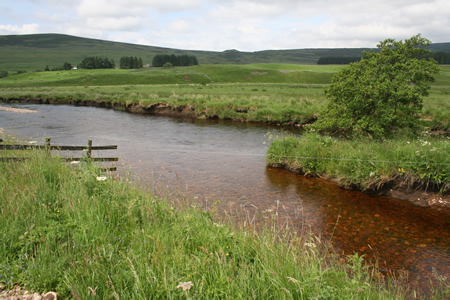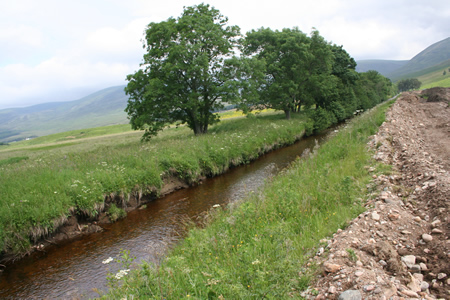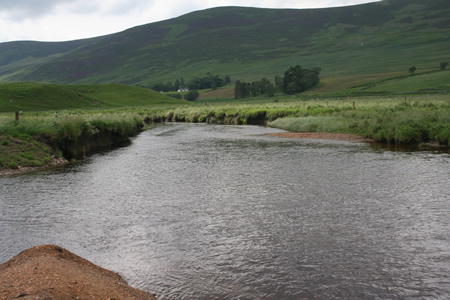These bulletin blogs represent news about Finavon and the South Esk, and my views as a riparian owner. They are not the views of any other organisation, nor are they designed to promote the interests of any individual or organisation other than Finavon Castle Water and factors affecting the fishery. Tony Andrews
The Rottal Burn drains the north side of Glen Clova through the Kennet Burn, two burns off Finbracks (2,478′) and another two burns from the northwest. These 5 burns join together above some waterfalls to form the Rottal Burn, which flows from just upstream of Rottal Lodge for about one mile before joining the South Esk between Drums and Kilburn. The Rottal is a sizeable burn with excellent substrata of gravels and cobbles, ideal for spawning salmonids. Like many of the South Esk’s tributaries the Rottal Burn has been abused to allow drainage of adjacent farming land. In the case of the Rottal Burn the damage caused by derdging was the removal of virtually all juvenile salmonids habitat.
The Rottal Restoration Project is supported by the South Esk Catchment Management Partnership, which includes the Esk Rivers and Fisheries Trust, SEPA, Angus Council, SNH, the Forestry Commission, the Cairngorm National Park Authority and others. But the accolade must go to Marshall Halliday, Director of the Esk Rivers and Fisheries Trust, who has driven the restoration from Day One. It is an innovative and pioneering project, and a wonderful boost for everyone who loves the River.
The Rottal ‘Ditch’. Great flow, clean water, terrific spawning cobbles and gravels, but nowhere for little fish to grow up in safety.
There was a nice report in The Courier on the 16th of June describing the Esks Fisheries Trust’s project to restore the Rottal Burn. This important upper catchment tributary was severely damaged by a dredging operation in 2003, preceded by alterations to its course over two centuries. Fortunately, the original course of the burn is recorded in eighteenth century maps, and they have provided the inspiration for the restoration project. In an alluvial plain, as Glen Clova is, tributaries move about, so any naturally formed river or stream course is likely to have changed many times over the centuries. Nevertheless, the 18th century map gives us the most recent of these natural morphological changes, and there is merit in that as a starting point.
The purpose of the project is habitat enhancement, but not only for wild salmon and sea trout. In the South Esk catchment the freshwater pearl mussel Margaritifera margaritifera is a target for conservation, supported by its EU protected status. The parasitic relationship between the larva of the mussel (Glochidia) and upstream migrating salmon and sea trout, where the larva resides in the gills of the fish, before dropping off into upstream gravel locations to establish new mussel colonies, or strengthen existing ones, is a major justification for the Rottal project. A real success measure would be to find a new colony of MM in the burn following completion of the project.
This photograph shows the existing Rottal Burn downstream of the bridge on the north road of Glen Clova. Although the Rottal Burn is an ‘alt’ (i.e. with waterfalls impassable to migratory fish) the available spawning and juvenile potential habitat, quality of gravels and cobbles, and flow in the burn, make it a very important upper catchment tributary for all of its length downstream of the waterfalls. If the outcome of the Rottal restoration project is good quality habitats for both spawning and juvenile growth, the project will have been worthwhile, and that is before taking into account other benefits from the enhanced local environment.
 The existing confluence of the Rottal Burn with the South Esk in Glen Clova. This photograph shows the depth to which the Rottal Burn was dredged in 2003, the effect of which was to lower the water table in the vicinity of the burn in its lower reaches. The immediate riparian habitat was damaged by loss of the ‘sponge effect’, as well as in-stream habitats for juvenile salmon and sea trout. One big advantage of the restoration project is that salmon and sea trout are already using the gravels and cobbles of the Rottal Burn to spawn. With improved juvenile habitats after completion of the project the survival of fry to parr to smolts should improve. We might expect S2 and S3 smolts from the restored burn.
The existing confluence of the Rottal Burn with the South Esk in Glen Clova. This photograph shows the depth to which the Rottal Burn was dredged in 2003, the effect of which was to lower the water table in the vicinity of the burn in its lower reaches. The immediate riparian habitat was damaged by loss of the ‘sponge effect’, as well as in-stream habitats for juvenile salmon and sea trout. One big advantage of the restoration project is that salmon and sea trout are already using the gravels and cobbles of the Rottal Burn to spawn. With improved juvenile habitats after completion of the project the survival of fry to parr to smolts should improve. We might expect S2 and S3 smolts from the restored burn.
The photographs above show how the existing dredged channel of the burn has reduced it to little more than a high energy ditch, albeit with some very good quality cobble, suitable for spawning salmon. The problem as far as migratory salmonids are concerned has been the lack of habitat for fry and parr. With bankside foliage removed and the burn reduced to a shallow high energy riffle over gravels and cobble, there are no pools or refuges for little fish as they grow bigger.
Glen Clova is, or should be, rich in wildlife. The restoration of the Rottal Burn will provide additional wetland habitat for, amongst others, various species of wading birds such as curlews, snipe, oyster catchers and green plovers (lapwings). Amphibians such as frogs and newts and a wide range of species of invertebrate, including many species of lepidoptera, will also be encouraged to return to levels of natural abundance. After completion of the restoration project, the existing deep drainage channel of the burn will no longer exist, resulting in a raised water table, encouraging wild flowers, grasses and reeds, and thereby improving the adjacent riparian habitat.
The photographs below show how the Rottal Restoration Project has approached the problem of ‘kick-starting’ the morphological processes that will, over time, lead to a natural sequence of riffles and pools through a series of bends and changes in gradient. It is important to recognise that an artificial stream bed, as will be the situation in the Rottal Burn on completion of the project, will not be the final product, because the forces of natural flow variations, especially in times of spates, will have the ultimate say in sculpting the bed of the stream, eroding banks and depositing gravel bars. But the imaginative, sensitive and at times, subtle, work done by McIntosh contractors of Echt is giving natural morphology a great start. I am in no doubt that, when trees and shrubs grow up along the banks of the burn, and pools on corners develop deeper pockets where small fish can escape from predators or shelter in times of spate, the burn will have significant holding capacity for juveniles.
These photographs show phase 1 of the Rottal Project completed. It involved sculpting the course of the burn, derived from old maps that showed the course of the burn in the 18th century. The contractor has not been tempted to make dramatic changes, and instead has chosen to make a fairly shallow channel which meanders along and around old contours to the east of the canalised section of the burn downstream of the road.
Of course Phase 2 of the restoration will require the filling in of the canalised or ‘ditch’ section so that the flow of the whole burn can be added to the limited flow that is currently piped into the new course of the restored burn. That will take time, and will probably be quite messy, especially in wet weather. But in this part of the world one year makes a terrific difference; with another’s summer’s growth and more tree planting done, the new burn course will settle in quickly and, from my own experience I would guesss that inside five years it will look as if it was never any different! Trees, bankside foliage and natural morphology will soon make the Rottal Burn what it once was.
The new confluence with the South Esk is about 300 yards downstream of the current confluence. Phase 2 of the project will probably take place in early September. Between now and the beginning of Phase 2 a gentle flow of water runs through a pipe from the canalised section which has had the effect of cleaning the gravels and cobbles in the top 300 yards or so of the restored section. It is deeply reassuring to see the clean gravel there, although further down the restored section, nearer to the confluence, there is still a predominance of gritty silt. If the September date is met, and Phase 2 completed during that month, it will lead to gravels and cobbles being cleaned down the whole length of the burn by the end of October, providing every chance of salmon spawning there in November and December 2012.
 The photo above shows how the contractor has started the morphological process ‘by suggestion rather than statement’. The point is that he has created a situation where natural morphology can take over and form the new burn. It is a clever and subtle piece of landscape engineering, and deserves recognition for not taking the engineering part of the project too far.
The photo above shows how the contractor has started the morphological process ‘by suggestion rather than statement’. The point is that he has created a situation where natural morphology can take over and form the new burn. It is a clever and subtle piece of landscape engineering, and deserves recognition for not taking the engineering part of the project too far.
Another view of the sculpted channel waiting for a full flow of water.
Bends in the lower section of the burn, just upstream of the confluence with the South Esk, use natural contours (in this photo glacial deposits) taking the Rottal Burn back to its original meandering course.
Looking towards the confluence with the South Esk down the freshly sculpted channel of the original course of the Rottal Burn
This is the newly made confluence of the South Esk with the restored channel of the Rottal Burn. The total length of the new channel, following the flood plain contours and meandering towards the river with bends and gradients, is about 1000 yards; One thousand yards of spawning and juvenile fish habitat, perhaps for our spring salmon. If the burn were to produce 1000 smolts every year, which is certainly possible, there could be another 50 spring salmon into the South Esk!






